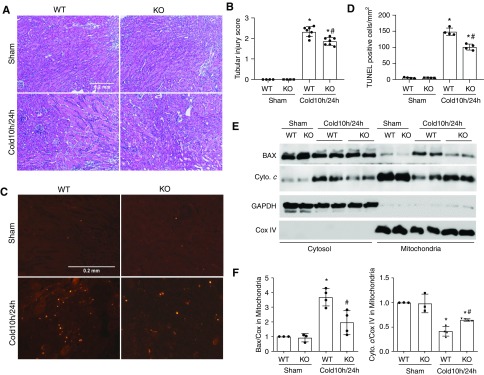Figure 3.
PKCδ deficiency in donor kidneys reduces cold storage–associated transplantation injury. The left kidney was collected from PKCδ-KO or WT mice for 10 hours of cold storage, followed by transplantation into WT mice for 24 hours. The right kidney of donor mice without cold-storage transplantation was used as sham control. Kidneys were either fixed for histologic examination or fractionated into cytosolic and mitochondrial fractions for immunoblot analysis. (A) Representative images of hematoxylin and eosin (H&E) staining. Scale bar, 0.2 mm. (B) Pathologic score of tubular damage. (C) Representative images of TUNEL staining. Scale bar, 0.2 mm. (D) Quantification of TUNEL-positive cells. (E) Representative immunoblots of kidney cytosolic and mitochondrial fractions showing Bax translocation to and cytochrome c release from mitochondria in cold-storage transplantation kidneys. COX IV and glyceraldehyde-3-phosphate dehydrogenase (GAPDH) were used as the loading controls of mitochondrial and cytosolic fractions, respectively. (F) Quantification of Bax and cytochrome c (Cyto. c) in mitochondria. Data in (B, D, and F) are expressed as mean±SD (n=4–7). *P<0.05 versus the respective sham-operated groups, #P<0.05 versus transplanted WT kidneys.

